

Infographic: How Big A Backyard Do You Need To Live Off The Land? Planning Your First Vegetable Garden. Intensive Cropping This type of planting a garden with vegetables means using in wide bands, generally 1-4 feet across and as long as you like.
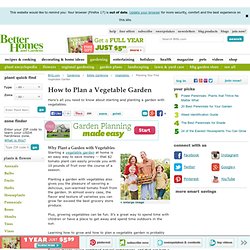
Intensive cropping reduces the amount of area needed for paths, but the closer spacing of the plants usually means you have to weed by hand. "Edible Landscaping Online" Garden Layout Ideas" Creating A Base Map For Landscaping Your Yard. Plats are useful for locating easements on a property, but not every state plats lots.
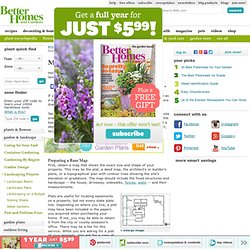
Depending on where you live, a plat may have been included in the papers you acquired when purchasing your home. If not, you may be able to obtain it from the city or county assessor's office. There may be a fee for this service. While you are asking for a plat of your property, also ask for a copy of all local ordinances regarding easements, height restrictions, and any other regulations that may have an effect on your landscaping project. Make several copies of the plat; label and store the original in a safe place. The Old Farmer's Almanac Garden Planner. Garden Calendar: Sowing & Planting Times. Canada Frost Freeze Freezing Dates Chart. Below is a chart showing frost dates in the spring and fall for various Canadian cities.
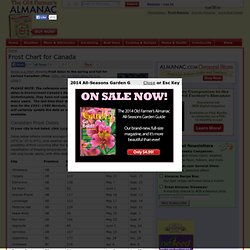
(Also, see our frost dates for U.S. cities.) PLEASE NOTE: The reference source for Canadian frost dates is Environment Canada's National Climate Services. Unfortunately, they have not updated the information in many years. The last time their data set was calculated was for the 1951–1980 Normals. Here at the Almanac, we will certainly update the data as soon as it is made available. If your city is not listed, click here. Dates below reflects normal averages for a light freeze (29° to 32°F, or -2° to 0°C); local weather and topography may cause considerable variations. How To Build & Fill A Raised Bed. What is a raised bed?
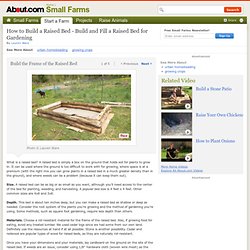
A raised bed is simply a box on the ground that holds soil for plants to grow in. It can be used where the ground is too difficult to work with for growing, where space is at a premium (with the right mix you can grow plants in a raised bed in a much greater density than in the ground), and where weeds can be a problem (because it can keep them out). Size. A raised bed can be as big or as small as you want, although you'll need access to the center of the bed for planting, weeding, and harvesting. A popular bed size is 4 feet x 4 feet. Depth. Materials. Once you have your dimensions and your materials, lay cardboard on the ground on the site of the raised bed. Then, cut and fasten the four sides together in place on the site of the bed.
Circle Planting. I wanted to grow corn between two rows of tomato vines to provide partial shade for vines and tomatoes.
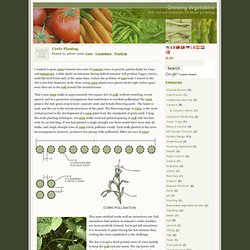
A little shade on tomatoes during hottest summer will produce bigger, juicier, mild-flavored fruits and, at the same time, reduce the problem of sun-scald. I traced in the dirt a two-foot diameter circle. Nine young corn plants were placed about eight inches apart, were then set in the soil around the circumference. That’s nine corn stalks in approximately two square feet of soil, without crowding, evenly spaced, and in a geometric arrangement that contributes to excellent pollination.The corn plant is the only grain crop to have separate male and female flowering parts . 7 No-Cost Ways To Grow More Food From Your Garden. When I wrote a post about products that help promote soil biodiversity, some commenters were skeptical about commercial products that are shipped long distances with all the packaging and waste that goes with them.
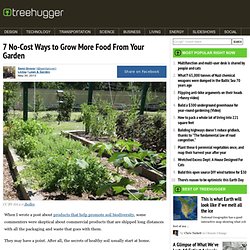
They may have a point. After all, the secrets of healthy soil usually start at home. And many of them are free. Here are some of our favorites normanack/CC BY 2.0 Compost everythingFirst and foremost, if you want to build healthy, lively soils, you first have to add food for the soil microbes that inhabit it. Mulch, mulch, mulchMulching is a great way to reduce water use, suppress weeds and protect soils from drying out or erosion. Ivy Dawned/CC BY-SA 2.0. Companion Planting. Planning Succession Crops. Succession planting will allow you to plant several times throughout the growing season for a continuous supply of fresh vegetables.

To plan succession crops you must know two things: • The number of weeks of growing season in your garden. The length of the growing season is the number weeks between the last frost in spring and the first frost in autumn. The local cooperative extension office can tell you the length of the growing season in your location or you can ask an experienced gardener at a nearby garden center. • The number of weeks each crop you wish to grow requires to germinate, grow, and reach harvestable size.
Plants For A Future : 7000 Edible, Medicinal & Useful Plants. NewCROP HomePage. Horticulture and Landscape Architecture|Purdue University Help Strategies for using NewCROP CropINDEX A list of scientific and common names of crops for information access CropMAP A nation-wide (US) location-specific crop information system Current Projects Classes, presentations, websites CropREFERENCE Books and manuals on crops CropEXPERT Directory of new crop resource personnel NewCropEVENTS Conferences, events and upcoming symposia IMPORT—EXPORT Plant quarantine information and phytosanitation permits for all countries.
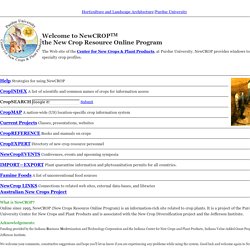
Landscape For Life.org. Plant Hardiness Zone Map. Farm Garden Calculator. Vegetable Garden Planner. Market Garden Planner.